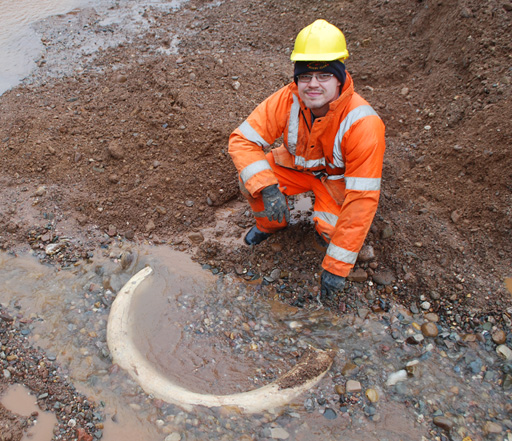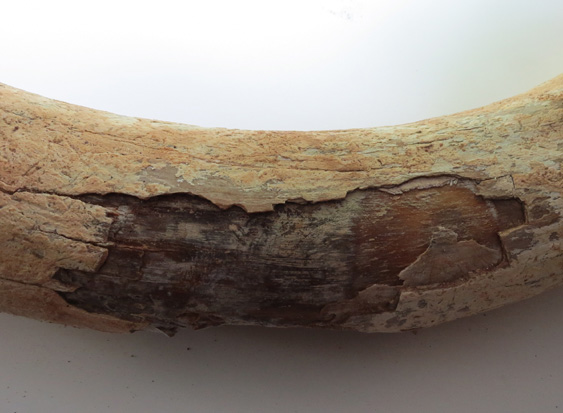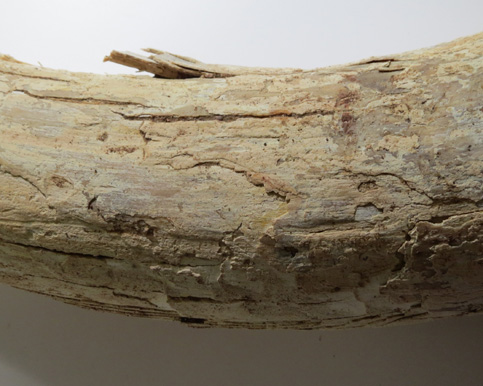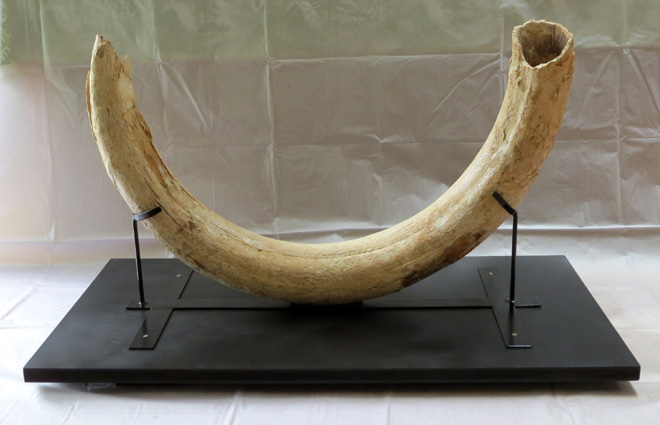 This reasonably complete tusk of a woolly mammoth (Mammuthus primigenius) was discovered in a gravel pit in Worcestershire.
The proximal end with the 'pulp cavity' is relatively complete but the distal end has been lost.
There is some damage to the midsection, but otherwise the tusk is in very good condition.
It was waterlogged when found (see photo to left) so it was covered in plastic to ensure that it dried out slowly to reduce the chances
of splitting and delamination which is the biggest problem with tusks that get wet.
This reasonably complete tusk of a woolly mammoth (Mammuthus primigenius) was discovered in a gravel pit in Worcestershire.
The proximal end with the 'pulp cavity' is relatively complete but the distal end has been lost.
There is some damage to the midsection, but otherwise the tusk is in very good condition.
It was waterlogged when found (see photo to left) so it was covered in plastic to ensure that it dried out slowly to reduce the chances
of splitting and delamination which is the biggest problem with tusks that get wet.




Once it had dried out enough the surfaces of the tusk were gently cleaned with a soft brush and where necessary with wooden spatulas and a scalpel (to remove patches of really stubborn sand and gravel). As the cleaning progressed, the specimen was consolidated with Paraloid B72 at 10% in acetone, with thicker consolidant (up to 20% in acetone) pipetted into the cracks and Paraloid B72 adhesive applied to breaks, to help hold the specimen together. Significant gaps were filled with a paste made from Paraloid B72 adhesive mixed with glass beads, 44 microns in size (see: Larkin, N. and Makridou, E. 1999. Comparing gap-fillers used in conserving sub-fossil material. The Geological Curator 7 (2), 81-90). These gap fills were then painted-out with artistsí acrylic paints to match the tusk.
The bespoke steel mount was made using blacksmithing and welding skills, was then sprayed with black satin paint and lined with inert black Plastazote foam
between the tusk and the metal to protect the specimen.
A wooden plinth was made from MDF, slightly larger than the length of the specimen, to protect it from knocks.
This was coated with two applications of Dacrylate varnish to reduce emissions of VOCs.
Pieces of wood are glued to the underside (with PVA wood glue) to enable fingers to get underneath the MDF to enable it to be easily lifted and moved.
The plinth was then sprayed with black satin paint to match the mount.
The mount is secured to the plinth with four metal screws and the tusk is simply lifted in to place. See below.

Once the project was completed, a wooden frame had to be built around the specimen to hold it firmly in place so that it would not move and
suffer damage on its journey back to Worcester.

For more details about what we can do for you, or for a quote, please contact:
enquiries@natural-history-conservation.com
We are members of the United Kingdom Institute for Conservation of Historic and Artistic Works